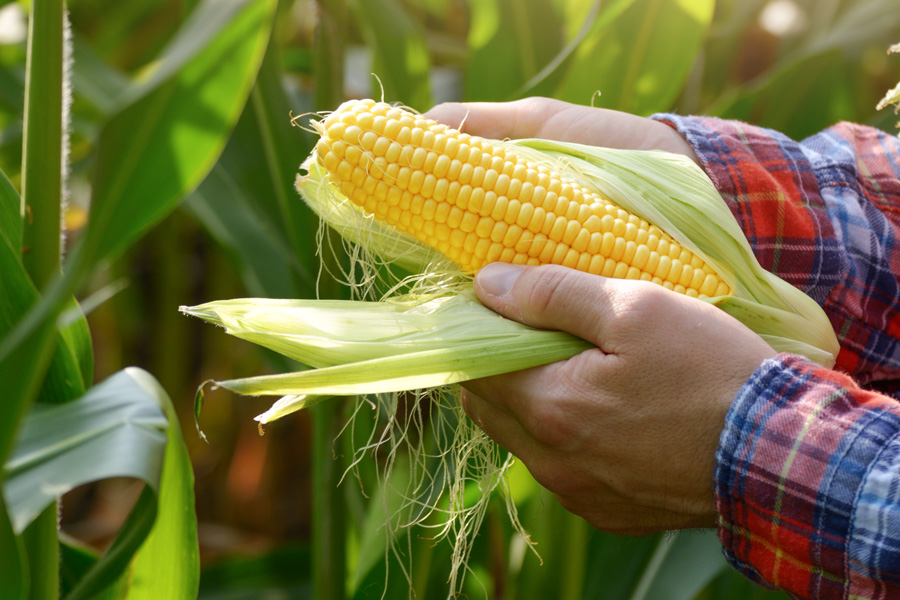Growing sweet corn in southern Georgia is a dynamic process that is influenced by various environmental factors. One of the most crucial factors that impacts the growth and development of sweet corn is accumulated heat units, measured in growing degree days (GDDs).
This publication provides sweet corn growers in the region with insights into the relationship between temperature and GDD units and the key growth stages of sweet corn. By understanding these relationships, growers can make informed decisions about the timing for planting, management practices, irrigation, and harvesting.
What are Growing Degree Days?
Growing degree days, also known as accumulated heat units, are used to measure the amount of heat accumulated over time during the growing season. Tracking GDDs provides valuable insight into crop development, especially for warm-season crops like sweet corn, as the growth and development of sweet corn is heavily dependent on temperature. At higher temperatures, sweet corn will develop faster than at cooler temperatures. Measuring in GDDs standardizes crop development regardless of season or location. For example, sweet corn’s time-to-harvest in southern Georgia varies between 59 to more than 80 days, depending on the season and daylight hours; however, the growing degree days to harvest are the same.
Crop development assessment and scheduling-management decisions are typically made by routine scouting and are largely based on historical experience. The benefit of using GDDs is that they rely on data, not personal observation or judgment. Likewise, GDDs provide a better estimate of the growth stage than calendar days because GDDs consider temperature’s effect on plant growth and development. Because of this, growing degree days are a dependable guide to follow when determining crop growth and development.
Calculating GDDs
Growing degree days are calculated by tracking daily temperatures and comparing them to a base temperature. A base temperature is a minimum threshold for successful germination or growth to occur. There is little growth that occurs below a crop’s base temperature. For sweet corn, the base temperature is 50 °F (10 °C). Similar to a base temperature, there also is a maximum temperature threshold for sweet corn, at which growth and development plateau. This maximum threshold value is 86 °F (30 °C).
To calculate GDDs, the first step is to calculate the average daily temperature. This can be done by adding the minimum and maximum daily temperatures and dividing that value by 2.
- If the mean (average) temperature is less than the base temperature (50 °F/10 °C), the GDDs will be zero.
- If the mean daily temperature is greater than the base temperature, then subtract the base temperature from the mean temperature value, as shown in the equation below:
GDDs=( (Max. Daily Temp. + Min. Daily Temp.) / 2 ) – 50
Calculating Modified GDDs
Modified growing degree days are a variation of GDDs that involves adjusting the temperatures when the daily minimum temperature is less than the base temperature (50 °F/10 °C) or if the maximum daily temperature exceeds 86 °F (30 °C). If the daily low temperature falls below 50 °F (10 °C), use 50 °F (10 °C) in your calculation. Similarly, if the daily high temperature exceeds 86 °F (30 °C), use 86 °F (30 °C) in your calculation. After making these adjustments, the average temperature for the day is calculated and compared to a base temperature of 50 °F (10 °C).
This method is commonly used to track the growth of sweet corn, assuming that development is restricted when temperatures go above 86 °F (30 °C) or below 50 °F (10 °C). For instance, if the high for the day was 92 °F (33.3 °C) and the low was 68 °F (20 °C), the average temperature for the modified GDDs calculation would be (86 + 68) / 2 = 77.
Example 1: A typical GDDs calculation.
With a daily maximum temperature of 84 °F (28.8 °C) and a minimum of 60 °F (15.6 °C), the GDD accumulation for the day would be ((84 + 60)/2) – 50, which equals 22 GDDs.
Example 2: The high temperature exceeds the daily maximum threshold.
If the daily maximum temperature reached 96 °F (35.6 °C) and the minimum was 70 °F (21.1 °C), the GDDs accumulation would be calculated as ((86 + 70)/2) – 50, resulting in 28 GDDs.
Example 3: The low temperature is below the daily minimum threshold.
With a daily maximum temperature of 70 °F (21.1 °C) and a minimum of 42 °F (5.56 °C), the GDD accumulation for the day would be calculated as ((70 + 50)/2) – 50, which equals 10 GDDs.
Calculating GDD Accumulation
After the daily GDDs value is calculated, add it to the running total to get the accumulated GDDs. GDD accumulation helps producers to schedule planting, predict crop development stages, and optimize management practices. By understanding the relationship between GDDs and sweet corn development, sweet corn producers can make informed decisions to maximize yield and quality.
Sweet Corn Growth Stages
Table 1 presents the GDDs associated with sweet corn growth stages and cumulative GDDs. The data in the table were generated by monitoring 12 spring and fall crops over 2 years in grower fields in southwestern Georgia planted to Bayer® Obsession™ varieties.
| GDDs | Estimated Growth Stage |
|---|---|
| 0–70 | Planting to Emergence |
| 71–140 | Emergence to V1 |
| 141–195 | V1 to V2 |
| 196–255 | V2 to V3 |
| 256–300 | V3 to V4 |
| 301–355 | V4 to V5 |
| 356–415 | V5 to V6 |
| 416–490 | V6 to V7 |
| 491–565 | V7 to V8 |
| 566–645 | V8 to V9 |
| 646–695 | V9 to V10 |
| 696–770 | V10 to V11 |
| 771–840 | V11 to V12 |
| 841–890 | V12 to V13 |
| 891–935 | V13 to Tasseling |
| 936–1050 | Tasseling to Silking (R1) |
| 1051–1190 | Silking to Blister (R1 to R2) |
| 1191–1345 | Blister to Milk (R2 to R3) |
| 1346–1400 | Harvest |
Germination and Emergence (0–140 GDDs)
Sweet corn’s growth begins with the germination stage. Seeds need adequate soil moisture and temperatures between 50–95 °F (10–35 °C) to germinate. Temperatures below 50 °F (10 °C) can lead to chilling injury, in which plant cells are damaged and root growth is aborted, resulting in poor germination or stunted growth. Germination usually takes place within 7 to 10 days after planting or 70 GDDs, depending on environmental conditions—particularly temperature and soil moisture. Following germination, sweet corn emerges. Seedlings develop root and shoot systems during this stage, and it’s essential to manage watering and weed growth carefully to support the seedlings. Pre-emergent herbicides and fertilizer need to be applied after seeding and before crop emergence. Pest and disease management is also crucial during this time.
Photo: https://blog-fruit-vegetable-ipm.extension.umn.edu/2021/04/2021-considerations-sweet-corn.html
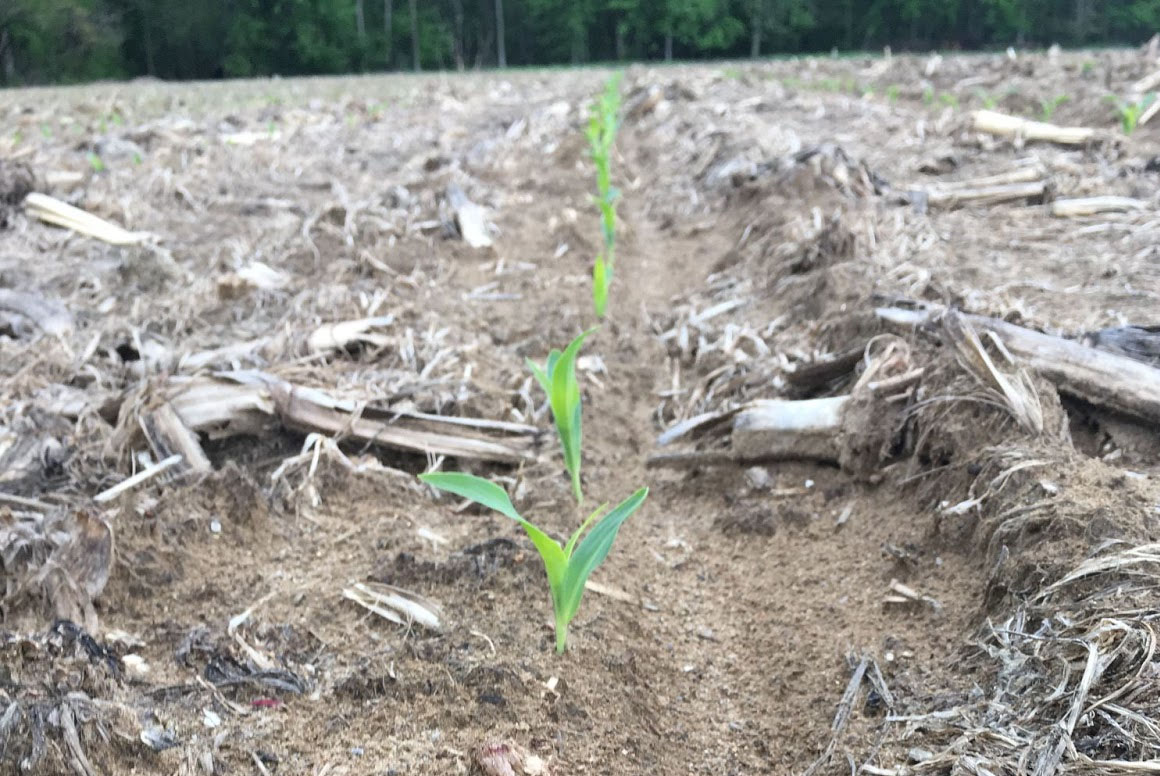
Vegetative Stages (V1-Vn; 141–890 GDDs)
In the vegetative stage, sweet corn grows quickly, forming approximately one to two new leaves per week, depending on temperature. This robust vegetative growth requires sufficient soil fertility, especially nitrogen. Side dressing is recommended near the V6 growth stage (approximately 416 GDDs). Similarly, weed control is vital at this time to prevent competition for nutrients and sunlight. Adequate irrigation is also necessary during vegetative stages to support healthy crop growth and development.
Photo: https://www.canr.msu.edu/news/targeting-corn-nitrogen-strategies-for-improved-resilience
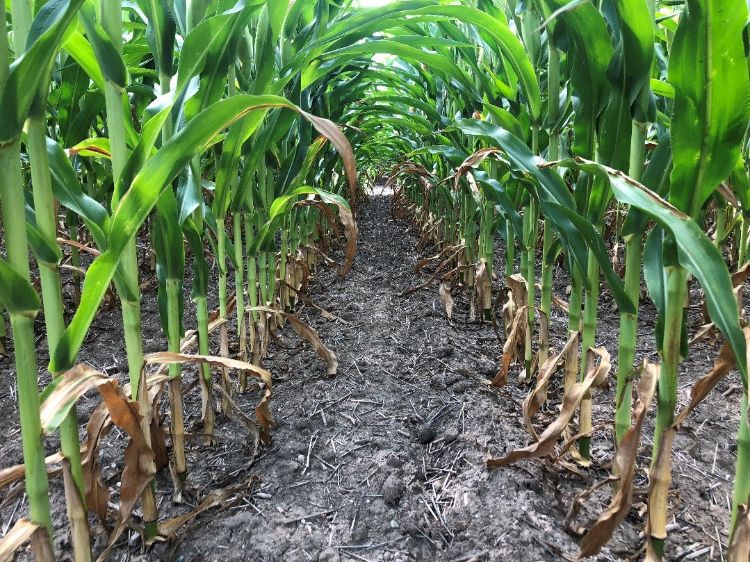
Tasseling, Silking, and Pollination (VT-R1; 936–1050 GDDs)
Tasseling is a critical phase in sweet corn development that marks the transition from vegetative to reproductive growth. During this stage, sweet corn plants produce tassels that contain pollen. Wind disperses pollen from tassels onto the silks emerging from the ears, which is pollination. Efficient pollination relies on adequate spacing between plants and uniform planting. Environmental factors such as temperature and humidity also have a large effect on pollination success. Temperatures exceeding 95 °F (35 °C) will terminate pollen grains and desiccate silks, leading to poor pollination—and in turn, yield loss. Spraying for corn earworm should also be done regularly from silking until harvest to ensure marketable ears.
Photo: https://blog-fruit-vegetable-ipm.extension.umn.edu/2021/04/2021-considerations-sweet-corn.html
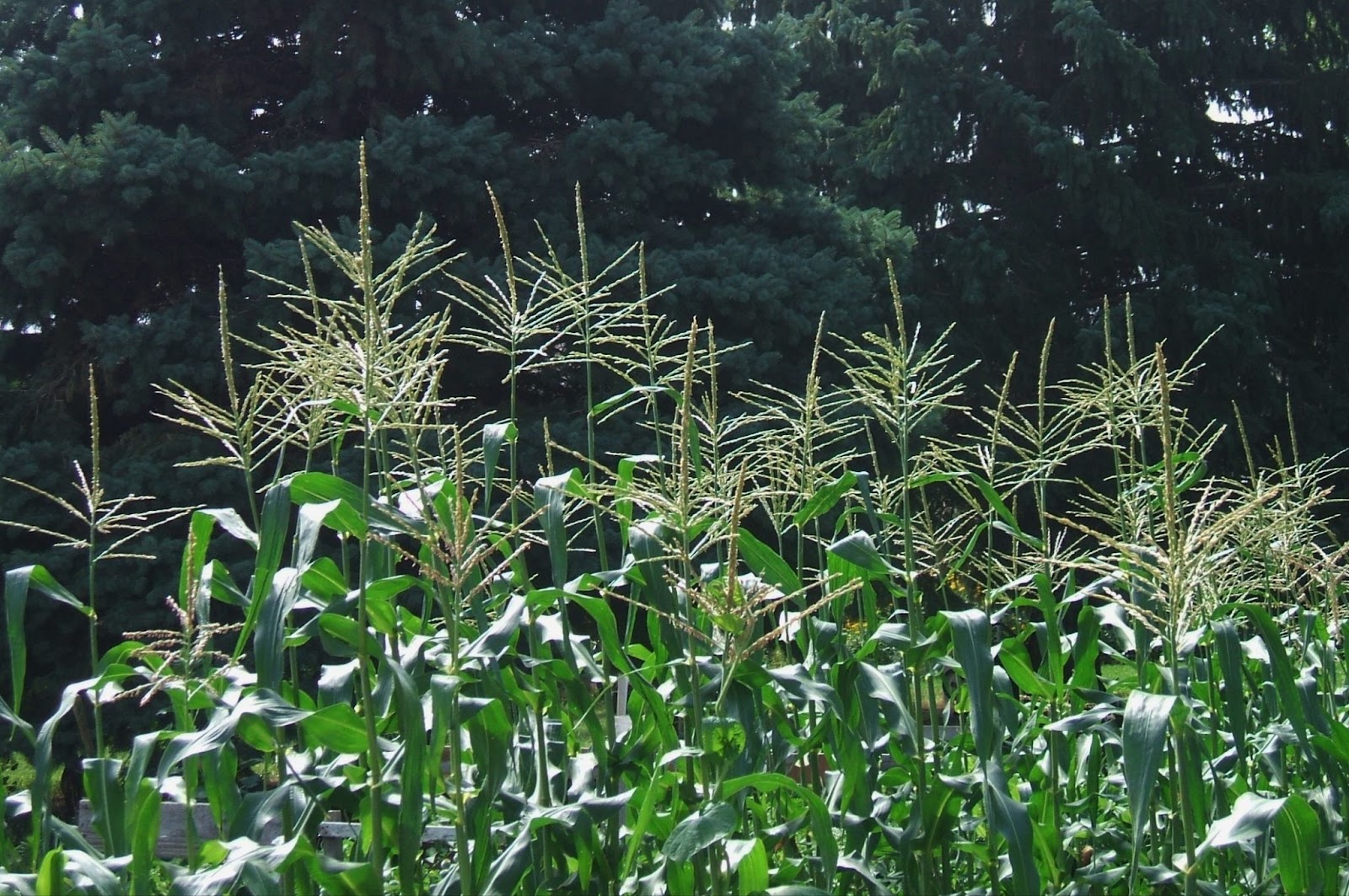
Ear Development (R2; 1051-1190 GDDs)
After successful pollination, sweet corn begins to develop ears. Fertilized silks turn brown, indicating successful pollination and embryo (kernel) development. The kernels then begin to swell, filling out the ears. It is critical to ensure optimal irrigation during this time, as adequate moisture supports kernel filling and development to avoid potential yield loss.
Photo: https://www.agry.purdue.edu/ext/corn/news/timeless/GrainFill.html

Maturation and Harvest Stage (R3 – Harvest; 1346-1400 GDDs)
As sweet corn reaches maturity, kernels undergo physiological changes, transitioning from milky and full of moisture to doughy and hard. To ensure optimal flavor and sweetness, it is crucial to harvest sweet corn at the right time. Sweet corn is typically harvested when kernels are in the milk stage, or R3, which is characterized by a milky white liquid squeezed from the kernel. The harvest window for sweet corn is about 3 days. Overmature ears may become tough and starchy, and immature (or under-mature) ears will have small, underdeveloped kernels, both of which adversely affect quality. Harvesting should take place in the cooler early morning temperatures to preserve sweetness.
Photo: https://www.vegetables.bayer.com/us/en-us/products/sweet-corn/details.html/sweet-corn_obsession_usa_seminis_fresh_market_open_field_fresh_market_west.html
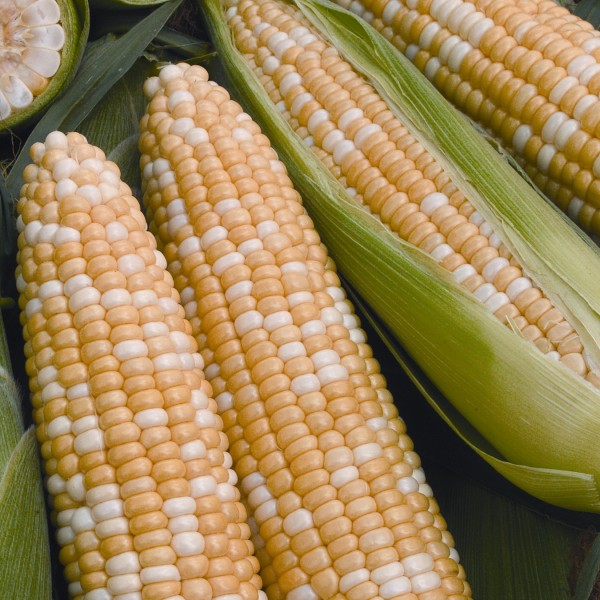
Conclusion and Resources
By using the information provided in this publication and Table 1, sweet corn growers in southern Georgia can better understand and forecast their sweet corn crops’ growth and development. This approach is proactive and considers accumulated GDDs, which can help growers make timely, proactive decisions and achieve the best possible regional sweet corn production. These values are a result of data collected from sweet corn grown in southern Georgia; therefore, they are representative of sweet corn growth and development in this region.
For specific irrigation, fertilizer, pest, or weed management guidelines, please refer to the following UGA Extension resources:
- For fertilizer and irrigation management recommendations, read Bulletin 1549, Shipper sweet corn in southern Georgia (https://extension.uga.edu/publications/detail.html?number=B1549).
- Insect, disease, nematode, and weed control recommendations can be found in the current edition of the Georgia Pest Management Handbook—Commercial Edition (https://ipm.uga.edu/georgia-pest-management-handbook/)

